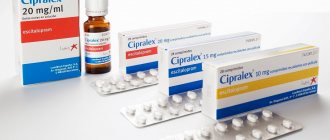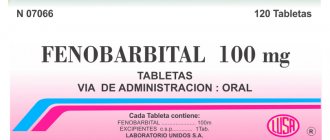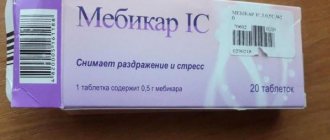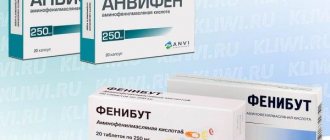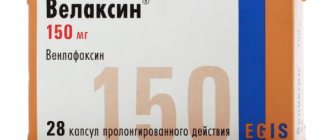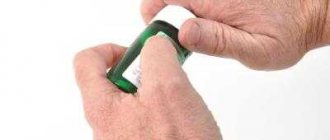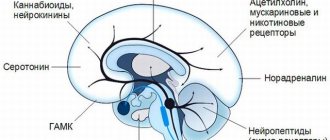- during the period of rehabilitation therapy after orthopedic, surgical or traumatological operations (this is due to the ability of Tolperisone to have a beneficial effect on the degree of stretching of muscle fibers );
- for the symptomatic treatment of muscle spasm in adult patients who have had a stroke ;
- as part of complex therapy for obliterating vascular (according to the annotation, the drug is effective for diabetic angiopathy , Raynaud's syndrome , thromboangiitis obliterans , etc.);
- for pathologies caused by disorders of vascular (severe gait disturbances or pathological cyanosis of the extremities).
Release form and composition
The medicine Mydocalm is available in the form:
- White coated tablets, biconvex, with one-sided engraving “50” or “150”. The content of tolperisone hydrochloride in one tablet is 50 or 150 mg. Additional substances: lactose, colloidal silicone, citric acid, stearin, microcrystalline cellulose, talc, starch, polyethylene glycol, titanium dioxide, iron oxide, dye.
- Solution for injection in ampoules of 1 ml. 1 ampoule contains 100 mg of tolperisone and 2.5 mg of lidocaine. Additional substances: parahydroxybenzoic acid methyl ester, diethylene glycol ethyl ether, water for injection.
Pharmacological characteristics
Pharmacological group - muscle relaxants of a central type of action, promoting a complete decrease in the tone of skeletal muscles. The mechanism of activity of the drug is still being studied, since it has only been partially explained. It has been proven that tolperisone reduces neuromuscular conduction and relieves pain in tight muscle groups.
The drug counteracts the toxic effects of strychnine on the body and has antispasmodic and antiadrenergic effects. The medicine also has an anticholinergic effect on the central nervous system. After oral administration, the medicine is absorbed only by a fifth of the entire dose taken at a time in milligrams.
The drug is processed primarily in the liver and excreted through the kidneys. Almost all of the substance taken is metabolized to inactive compounds. With intravenous and intramuscular administration of the drug, everything is different: then it is absorbed well, almost completely when used by drip.
Active ingredients
As already mentioned, Mydocalm includes several active ingredients. And each of them has its own mechanism of action and its own point of application.
Tolperisone
Tolperisone hydrochloride belongs to the group of central muscle relaxants. In order to understand the mechanism of action of the drug, let’s say a few words about the device for transmitting nerve impulses.
This process takes place in specific areas of our body - synapses. A synapse is a site where two neurons contact each other and where a nerve impulse is transmitted from one cell to another. The membrane of the nerve cell transmitting the impulse secretes a specific substance - a neurotransmitter, which has an exciting or inhibitory effect on the “receiving” cell.
Tolperisone has a stabilizing effect on the membrane of the “acting” nerve cell and blocks the release of the neurotransmitter, thereby blocking the transmission of the nerve impulse to the “receiving” neuron, resulting in an inhibitory effect and slowing down the excitation processes.
In addition to the membrane-stabilizing effect, the drug improves peripheral blood flow and blood rheology.
The drug is safe for the body, because it is completely excreted through the kidneys in the form of metabolites. And when undergoing repeated courses of therapy, the drug does not have a negative effect on organs and systems and does not affect their functioning.
Lidocaine
Lidocaine hydrochloride is included in the solution for injection, available in ampoules. It has a pronounced analgesic effect, which ensures relatively painless administration of the drug (this property is especially important when administering the drug intramuscularly). The instructions for the drug indicate that this substance does not have a systemic effect on the body and works exclusively at the injection site.
Why is Mydocalm prescribed?
Indications for use are:
- pathologically increased muscle tone and spasms of skeletal (striated) muscle tissue, which are a consequence of organic lesions of the central nervous system, including multiple sclerosis, encephalomyelitis, cerebral stroke, etc.;
- myogenic contractures, increased muscle tone and spasticity caused by diseases of the musculoskeletal system (for example, lumbago with sciatica, spondylosis, arthrosis affecting large joints, cervical syndrome, etc.);
- non-inflammatory diseases of the brain accompanied by disorders of muscle tone (for example, cerebral palsy);
- cholelithiasis;
- severe pain syndrome, observed against the background of the development of hemorrhoids;
- menstrual pain syndrome;
- the threat of spontaneous abortion due to increased tone of the uterine muscle structures;
- renal colic.
The use of the drug Mydocalm is indicated:
- during the period of rehabilitation therapy after orthopedic, surgical or traumatological operations (this is due to the ability of tolperisone to have a beneficial effect on the degree of stretching of muscle fibers);
- as part of complex therapy for obliterating vascular lesions (according to the annotation, the drug is effective for diabetic angiopathy, Raynaud's syndrome, thromboangiitis obliterans, etc.);
- for the symptomatic treatment of muscle spasm in adult patients who have had a stroke;
- for pathologies caused by disorders of vascular innervation (severe gait disturbances or pathological cyanosis of the extremities).
Mydocalm: effect of use
What is this drug good for and what does it help with?
During controlled experiments, it was proven that Mydocalm reduces the hypertonicity of muscle tissue and its rigidity, thereby reducing pain and eliminating muscle spasms of any localization. In addition, patients note significant relief in performing voluntary actions, i.e., the amplitude of movements increases.
Additional effects of the drug include antispasmodic and improved blood circulation.
The drug does not have any effect on the cortical parts of the brain, thus it does not affect human consciousness and behavior.
Instructions for use
Mydocalm tablets are taken orally after meals. Do not chew them and wash them down with plenty of water. The average therapeutic dosage of the drug depends on the patient’s age:
- Children aged 3-6 years – 5 mg per 1 kg of body weight in 3 doses during the day.
- Children aged 7-14 years – 2-4 mg per 1 kg of body weight in 3 doses during the day.
- Children over 14 years of age and adults – 50 mg 2-3 times a day. If necessary, the dosage can be increased to 150 mg 2-3 times a day.
The duration of use of Mydocalm tablets is determined by the doctor individually, depending on the nature and severity of the pathological process.
With the dosage of the injection solution everything is simpler. Mydocalm is administered intramuscularly 2 times a day, morning and evening, 1 ampoule at a time.
If intravenously, it can be administered slowly, as a bolus, and only once a day, since the bioavailability of this method of using the drug is maximum. The duration of therapy is determined by the attending physician, depending on the severity of the disease and the condition of the patient, as indicated in the instructions for use.
Can I drink alcohol while taking the drug?
In relation to any drug, it is difficult to expect an affirmative answer to such a question. Alcohol, even in small doses, has a powerful effect on the entire body, and such a “shake-up” can be poorly combined with the influence of the drug. During therapy with Mydocalm, it is strictly forbidden to take both at the same time.
If circumstances are such that you have to drink alcohol, you need to at least take breaks.
- For men, it is permissible to drink a little no later than 24 hours before taking the medicine.
- For women, the period increases to 32 hours.
- After alcoholic drinks, men can take Mydocalm no earlier than 14 hours later, women - after a 20-hour break.
Contraindications to the use of Mydocalm
According to the instructions for use, it is not recommended to use the drug in the following cases:
- allergic reactions to lidocaine (when used by injection);
- hypersensitivity and individual intolerance to the active substance of the drug (tolperisone hydrochloride) or any component;
- myasthenia gravis;
- children's age from birth to 3 years when used in tablet form;
- children's age from birth to 1 year when used in the form of injections.
Read also: Why is Afobazol prescribed? Instructions, reviews and analogues, price in pharmacies
Analogues of the drug Mydocalm and prices
In the group of centrally acting muscle relaxants, there is a whole range of n-anticholinergics, which may well act as substitutes for Mydocalm, since they are produced in the same form and have similar pharmacodynamics.
Like Mydocalm, you can buy them at the pharmacy only with a prescription:
- Nothrixum;
- Ridelat-S;
- Tracrium;
- Mivacron;
- Aperomide;
- Pipecuronium bromide;
- Croiron;
- Esmeron;
- Ditylin;
- Listenone;
- Tolisor;
- Tolperisone hydrochloride;
- Tubocurarine;
- Nimbex.
The cost of the most effective and common drugs, both Russian and foreign, is presented in the table:
| Name | Price, rub.) |
| Mydocalm | 600 |
| Listenon | 200 |
| Tracrium | 1000 |
| Esmeron | 1600 |
| Nimbex | 1700 |
Side effects
Sometimes when taking Mydocalm a number of side effects may occur:
- myasthenia of the upper and lower extremities;
- severe headache;
- diplopia;
- spots before the eyes;
- lability and decrease in blood pressure (BP);
- nausea;
- skin itching;
- the appearance of erythematous spots;
- dyspepsia.
Sometimes there are:
- Allergic manifestations.
- Bed-wetting.
- Violation of UAC indicators.
- Heart pain, rhythm disturbance.
- Constipation, pain in the abdominal area.
- Bleeding from the nose.
- Redness of the skin.
- Skin rashes.
Rarely occur:
- Suffocation.
- Anemia.
- Chest pain.
- Increased release of creatinine.
The product belongs to the group of low-toxic compounds. It has been clinically proven that a single dose exceeding 300–600 mg in children causes increased irritability and nothing more. There is no antidote in case of overdose; you need to rinse the stomach and carry out forced diuresis.
As a rule, all of the above phenomena disappear if the consumed dosage is slightly reduced. It is extremely rare for patients to develop anaphylactic reactions, acute urticaria, erythema, shock, etc.).
How to take it for children?
According to the instructions for use of Mydocalm, children under fourteen years of age are allowed to be prescribed tablets containing 50 mg of tolperisone.
Children aged from one to six years are given the drug Mydocalm in a dose equal to 5 mg of tolperisone per kilogram of the child’s body weight per day. The indicated dose is divided into 3 doses during the day. In cases where the child is not able to swallow a whole tablet, it is first crushed.
For children from seven to fourteen years of age, the instructions for use of Mydocalm recommend prescribing the drug in a daily dose equal to 2 to 4 mg of tolperisone per kilogram of the child’s body weight. The multiplicity of techniques is 3.
During pregnancy and lactation
Naturally, the drug was not tested in order to study the effects on the body in humans, and especially not in women during pregnancy. But they observed how it acts on animals. No deviations in fetal development or deformities were noticed. However, in the first trimester of an “interesting situation,” the drug “Mydocalm” is never prescribed: it has already been said that experts have not fully understood the pattern of its effect on humans. And this is precisely the period when all important systems and organs are formed.
At later stages, such treatment is acceptable: no one has yet encountered a negative clinical picture, and on the “benefit-harm” scale, the gain for the expectant mother, according to the doctor, sometimes outweighs the potential damage to the baby in the womb.
You cannot breastfeed a baby and be treated with Mydocalm at the same time.
There is no information whether its active component passes into breast milk, and it is not worth the risk.
Analogs
Complete analogues:
- Calmirex tabs;
- Mydocalm Richter;
- Tolisor;
- Tolperisone;
- Tolperisone hydrochloride.
Drugs for the treatment of arthrosis include analogues:
- Alflutop;
- Amelotex;
- Apizartron;
- Arcoxia;
- Artradol;
- Arthrozan;
- Artrosilene;
- Arthroker;
- Arthromax;
- Arthroflex;
- Aertal;
- Betaspan Depot;
- Brufen;
- Voltaren;
- Genitron;
- Hydrocortisone;
- Dexalgin;
- Diklak;
- Diclovit;
- Dicloran plus;
- Diclofenac;
- Dimexide;
- Dolgit;
- Indomethacin;
- Ketonal;
- Ketorol;
- Xefocam;
- Liberum;
- Longidaza;
- Meloxicam;
- Movalis;
- Nise;
- Naklofen;
- Neurodiclovit;
- Nimesil;
- Nimesulide;
- Nimulid;
- Piroxicam;
- Sirdalud;
- Structum;
- Suplazin;
- Teraflex;
- Finalgel;
- Flamadex;
- Flamax;
- Chondroguard;
- Chondroxide;
- Chondroxide ointment;
- Chondroxide Forte;
- Celebrex;
- Elbona.
Drug interactions
Reviews from doctors about Mydocalm are positive. At the same time, most experts note that the greatest effectiveness from treatment with the drug can be achieved only by choosing the right dosage tactics, and also, in some cases, by correctly combining it with other medications.
Substances that potentiate the activity of Tolperisone: neurotropic B vitamins, non-steroidal anti-inflammatory drugs, clonidine, neuroleptics, peripheral muscle relaxants, anesthetic agents.
Pharmacological properties and pharmacokinetics
Pharmacists and doctors admit that it has not yet been fully studied how the medicine Mydocalm functions. However, we found out for sure that it:
- accumulates in the nervous system and affects the nerve endings of the brain;
- affects the sensitive branches of the nerves, slowing down the passage of nerve impulses through them;
- prevents cell membranes from breaking down, providing a clear membrane-stabilizing effect;
- in nerve cells it blocks the path to motor surges.
As a result, information from the muscles reaching the central nervous system (CNS) becomes limited and its response is switched off.
In addition, taking Mydocalm inhibits the release of neurotransmitters. These are substances, for example, adrenaline, that are involved in transmitting signals along nerve fibers. How he does it? It does not allow calcium, the ions of which are involved in the process of neurotransmitters, to pass into synapses - areas where cells “communicate”: in these places the processes of one nerve cell pass into another.
Another plus is local anesthesia, which does not affect the cerebral cortex. So neither drowsiness, nor lethargy, nor lethargy will interfere with the patient.
“Mydocalm” quickly, after half an hour (we’re talking about tablets), enters the bloodstream from the mucous membrane of the digestive system, from there it passes into the muscles and begins to work. It comes out just as quickly. The liver and kidneys are the first to get to work, converting the drug into metabolic products (metabolites), which are then removed from the body in the urine.
The remarkable thing is that neither the kidneys nor the liver suffer from this. So you can repeat the Mydocalm treatment as many times as your health requires.
What do the reviews say?
The drug is often prescribed to children diagnosed with hypertension. However, most parents do not risk giving it to children under one year old, given the age limit specified in the instructions, and limit treatment to physiotherapy and massage courses.
For this reason, there are not many positive reviews about the use of Mydocalm in children. By the way, some note as a disadvantage of the drug that the manufacturer does not have a dosage form in the form of a syrup, which would make it easier for infants to take.
2 143

